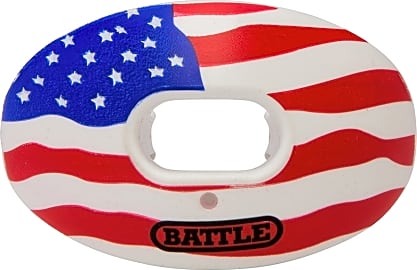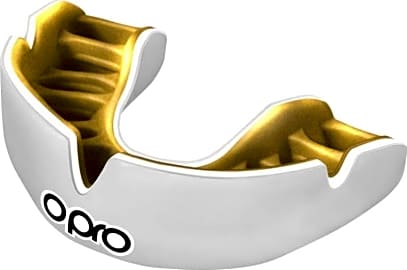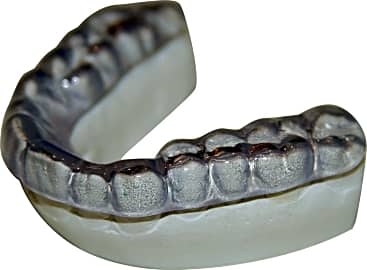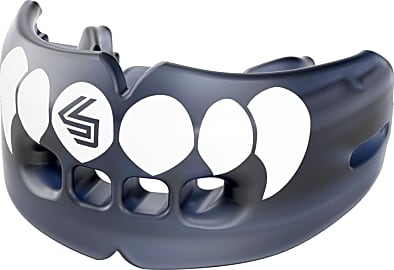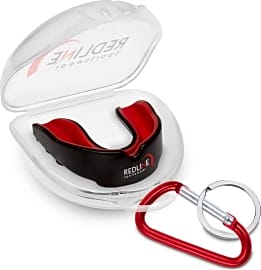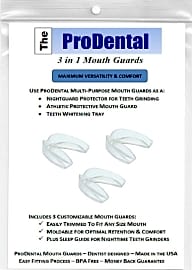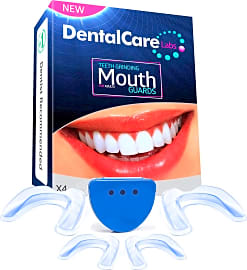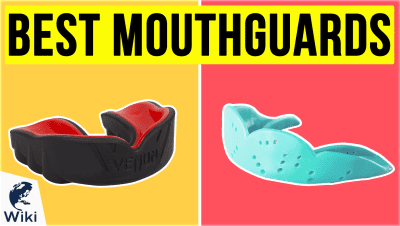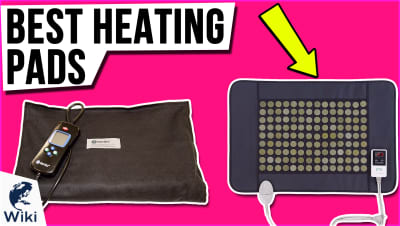The 10 Best Dental Guards

This wiki has been updated 39 times since it was first published in September of 2015. Once you get past puberty, you've only got one set of pearly whites to get you through the rest of your life, so protecting them against damage is a good idea. Whether you have a tendency to grind your teeth at night or participate in high-impact sports, these dental guards will keep your smile in great shape and provide welcome relief from the discomforts of bruxism, TMJ, and related conditions. When users buy our independently chosen editorial picks, we may earn commissions to help fund the Wiki.
Editor's Notes
April 10, 2020:
Dental guards can be used to protect the teeth during contact sports, or for nighttime protection against teeth grinding. Generally though, what is suitable for one activity often won't be an ideal choice for the other, which is why we included both types on this list. We wanted to make sure there would be to suit your purposes, whatever those may be.
While it is important that you get a secure and comfortable fit for both types of dental guards, it is especially so on those intended for nighttime use, since you will be wearing them for long periods on a daily basis. Because of this, many people often go to a dentist to get a custom set molded that perfectly matches their teeth, rather then settling for a boil and fit option. Of course, a trip to the dentist can be costly, so if you'd like to save a bit of cash, but still get a custom-made dental guard, you will want to look to the J&S Labs Custom, Chomper Grind Guards, and Sparkling White Smiles Soft But Strong. All three of these involve you creating a bite impression and then sending that off to the company for them to create a custom dental guard. While these are more expensive than boil and fit options like the Pro Dental 3-in-1 and DentalCare Labs Mouth Guards, they are still cheaper than actually visiting a dentist to get one made.
If you need something for combat sports like MMA and boxing, we recommend the Battle Oxygen American Flag; which can also help protect against a split lip; the Opro Power-Fit, and the Redline Sportswear Custom Fit. All three are thick enough to provide a lot of impact protection, without being so much so that they become uncomfortable. While the Sisu Aero does a better job of dispersing impact force than one would think considering how thin it is, we feel it is still better suited to basic contact sports, rather than martial arts.
Those wear braces and participate in sports will need the Shock Doctor Double or Battle Oxygen American Flag. The former is actually specifically made for use with orthodontia, so it should be your first choice for that particular use. It is worth noting that both of these will greatly interfere with speaking though.
If you need something for sports and, for whatever reason, aren't satisfied with any of our recommendations here, you may want to check out our list made specifically for sport mouthguards, which includes additional options.
Special Honors
Pro Teeth Guard Custom Pro Teeth Guard offers custom-made units from the same materials that dentists use, but for a fraction of the price. Not only do they have options designed for everything from light to heavy grinding, as well as an ultra-thin day guard, but they even offer a 110-percent money-back guarantee just in case you aren't happy with yours. proteethguard.com
Sisu Sense Contact and combat sports are rough on the body, even when wearing proper protection. With the Sisu Sense, you can be proactive about maintaining your health. It features an integrated sensor that measures the impact force behind every hit, and then transmits that data to an associated iPhone app where it is tracked and saved for later analysis. sisuguard.com
Protecting Those Chompers
The custom dental guard is then fashioned in a lab using the impressions taken from the user's teeth.
Regardless of whether you're an athlete, experiencing jaw problems, or having aesthetic enhancement work completed, a dental guard can keep your teeth protected. Also referred to as a night or mouth guard, the dental guard is typically a flexible and custom-fitted protective device that fully covers a person's teeth and gums to prevent or reduce the chances for injury.
Dental guards are classified into three types: stock or ready-made, boil-and-bite, and custom-made. Stock dental guards are sold as over-the-counter solutions available in pre-formed sizes and are usually the least expensive of all three types. Because they are purchased pre-formed, there is no customization available with the exception of minor trimming with a knife or scissors. For that reason, they do not always fit perfectly and have the tendency to be on the bulky side.
Boil-and-bite (or mouth-adapted) dental guards are also pre-formed and available over the counter. They are made from thermoplastic materials designed to be heated, placed in the mouth, and molded to fit more closely to a person's teeth. Boil-and-bite guards are most popular among amateur and semi-professional athletes.
Custom-made dental guards are the most comfortable and desirable type available. They are professionally-crafted by specialists to exacting specifications of a person's teeth using an impression kit with dental putty that can be used either in a dentist's office or at home, depending on the user's preference. The custom dental guard is then fashioned in a lab using the impressions taken from the user's teeth.
How To Guard Your Teeth
Besides protecting teeth from high-impact exercise by acting as physical barriers, dental guards offer many other advantages. They are often used in conjunction with bleaching gel to whiten the teeth. They are also used during dental restoration procedures, such as with crown work and when installing veneers. When applying topical medications for dental conditions, the guard is useful for keeping the medicine applied to a person's teeth and gums as long as possible.
They are often used in conjunction with bleaching gel to whiten the teeth.
Dental guards can also be used to treat disorders of the temporomandibular joint, particularly by alleviating pressure on the joint while reducing pain. These guards are especially useful for people who suffer from bruxism (or teeth clenching). Finally, the majority of dental guards are durable and relatively easy to keep clean.
The specific application required will determine the type of dental guard one invests in. In many cases, a guard is necessary to retain orthodontic work that has been completed (to prevent teeth from moving) as well as to prevent a person from clenching their teeth at night. For these reasons, custom-made guards are often the best choice due to their durability, flexibility, and ability to ensure a proper fit using an impression kit. Also, a custom-made guard offers one the choice of having their dentist take an impression or using the impression kit at home to accomplish this before sending it out to a lab for fabrication.
Ensuring that a dental guard is tasteless and constructed from BPA-free materials is also important. The last thing you want is to be tasting something weird in your mouth all the time. Some people are extremely sensitive to flavors, so the less foreign material that goes into your dental guard, the better off you'll be. In fact, the device should hardly be noticeable at all.
From Boxing To Bruxism: A Dental Solution That Fits
The most popular belief is that the dental guard was originally conceived for use in boxing and other high-impact sports. The earliest guards were simply small pieces of cotton, tape, sponge, or wood, which boxers would clench between their teeth. The problem with this early solution was that teeth clenching was distracting to boxers trying to focus on their opponents during a match. As an answer to this problem, British dentist Woolf Krause began producing dental guards for boxers in 1892 made from a natural rubber resin called gutta-percha.
From that point on, the dental guard was validated as an acceptable tool for use during boxing matches.
Krause's son, Philip, is generally credited with the development of the reusable dental guard, referred to as a gum shield, which was featured in a 1921 championship fight between Jack Britton and Ted Kid Lewis. Ted Lewis was a friend of the Krause family and the first professional to make use of the technology. The dental guard continued to grow in boxing relevance through the 1920s, particularly during a 1927 fight between Jack Sharkey and Mike McTigue. A chipped tooth that cut McTigue's lip forced him to forfeit the match. From that point on, the dental guard was validated as an acceptable tool for use during boxing matches.
Beginning in the 1930s, mouth guards gained mention within dental literature, particularly with respect to custom-made guards fashioned with rubber and wax impressions. Another major breakthrough occurred in 1947 when Los Angeles dentist Rodney O. Lilyquist used transparent acrylic resin to form what he called an acrylic splint. The splint was carefully molded to fit over the upper or lower teeth. This marked a significant improvement over earlier types of guards with thicker materials that boxers had been using. Constructed of thinner material, the acrylic guard provided athletes the ability to speak normally with the mouthpiece in place.
By January 1948, Lilyquist received national recognition for his dental guard when he described the procedure for making and fitting one in the Journal of the American Dental Association. By 1960, the American Dental Association recommended the use of latex dental guards for all contact sports and by 1962, all high school football players in the United States were required to wear the devices, followed by all US college students in 1973. Today, the dental guard has become synonymous with athletic safety as well as dental hygiene, protection, and restoration.




